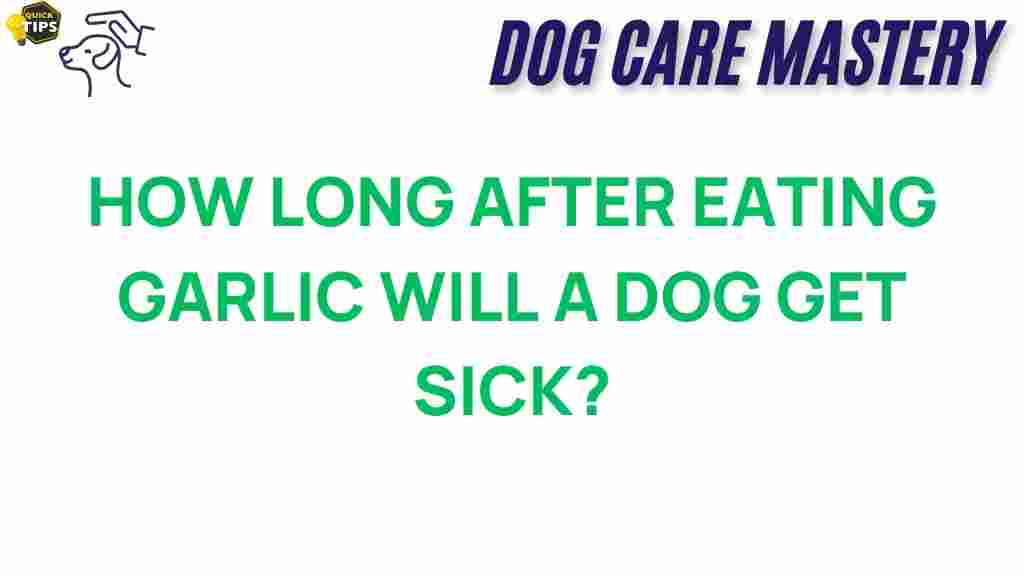The Hidden Dangers: How Long After Eating Garlic Could Your Dog Get Sick?
Garlic is a common ingredient in many kitchens around the world, praised for its flavor and health benefits for humans. However, when it comes to our furry friends, garlic poses hidden dangers that every dog owner should be aware of. This article will delve into the risks associated with garlic consumption in dogs, the symptoms of garlic poisoning, and what to do if your dog accidentally ingests garlic.
Understanding the Risks of Garlic
Garlic is part of the Allium family, which also includes onions, leeks, and chives. While these foods are generally safe for humans, they can be toxic to dogs. The primary component of garlic that is harmful to dogs is thiosulfate. This compound can lead to oxidative damage to red blood cells, resulting in a condition known as hemolytic anemia.
How Much Garlic is Dangerous?
The toxicity of garlic varies based on the amount ingested and the size of the dog. While a small amount of garlic may not cause immediate harm, it is crucial to understand that even tiny amounts can accumulate over time. Here are some guidelines:
- Small Dogs: As little as 1 clove can be dangerous.
- Medium Dogs: 2-3 cloves might lead to problems.
- Large Dogs: While they can tolerate slightly more, consumption of garlic should still be avoided.
Symptoms of Garlic Poisoning in Dogs
If you suspect your dog has consumed garlic, it’s essential to monitor for symptoms. The signs of garlic poisoning may not appear immediately and can take several days to manifest. Common symptoms include:
- Vomiting
- Diarrhea
- Abdominal pain
- Lethargy
- Weakness
- Rapid breathing
- Dark-colored urine (indicative of hemolytic anemia)
How Long After Eating Garlic Could Your Dog Get Sick?
After a dog consumes garlic, the onset of symptoms can vary. Generally, symptoms may appear within:
- 12 to 24 hours: for mild cases
- 2 to 3 days: for severe cases
It is crucial to seek veterinary attention immediately if you suspect your dog has ingested garlic, even if they appear fine initially.
What to Do If Your Dog Eats Garlic
If you realize that your dog has consumed garlic, follow these steps:
- Stay Calm: Panicking will not help your dog; take a deep breath.
- Determine the Quantity: Try to estimate how much garlic your dog has eaten.
- Contact Your Veterinarian: Provide them with all the necessary details about the ingestion.
- Follow Medical Advice: Your vet may recommend inducing vomiting or bringing your dog in for observation and treatment.
Inducing Vomiting at Home
In some cases, your veterinarian may advise you to induce vomiting at home. However, this should only be done under professional guidance. If your vet gives you the green light, follow these steps:
- Hydrogen Peroxide: Use 3% hydrogen peroxide (1 teaspoon per 10 pounds of body weight).
- Administer: Use a syringe or dropper to give it to your dog.
- Wait: Observe your dog for signs of vomiting within 15 minutes.
- Seek Help: If your dog does not vomit, contact your vet for further instructions.
Troubleshooting Tips for Dog Owners
To prevent future incidents, consider the following tips:
- Educate Yourself: Understand which foods are toxic to dogs.
- Secure Food: Keep garlic and other harmful foods out of reach.
- Monitor Diet: Ensure your dog’s diet consists of safe and suitable foods.
- Consult Your Vet: When trying new foods, always consult your veterinarian first.
Alternative Health Options for Dogs
If you are looking for ways to enhance your dog’s health without using garlic, consider these alternatives:
- Turmeric: Known for its anti-inflammatory properties.
- Ginger: Can aid in digestion and has anti-nausea effects.
- Pumpkin: Great for digestive health and can help with upset stomachs.
For more information on what foods are safe for dogs, check out this resource.
Conclusion
Garlic may be a staple in human diets, but it can be a hidden danger for dogs. Understanding the risks associated with garlic consumption is crucial for every dog owner. If your dog accidentally ingests garlic, remember to stay calm, assess the situation, and seek veterinary help. By taking preventive measures and educating yourself on safe foods for dogs, you can ensure your furry friend remains healthy and happy.
In summary, while garlic can add flavor to our meals, it should never be a part of your dog’s diet. Always prioritize their health and safety by keeping harmful foods out of their reach and consulting your veterinarian whenever in doubt.
This article is in the category Safety and created by dogcaremastery Team
